Table of Contents
*
F.I.D.O.: Allen Gordon
*
Nunavik Dog Slaughters, Part I
*
Pregnancy, Whelping and Pup Development in the ISD, Part II
*
Fan Mail
*
Tip for the Trail: Building a Dog Ramp
*
In the News
*
Behavior Notebook
*
Janice Howls: Transition to Primitive
*
IMHO: Change
Navigating This
Site
Index of articles by subject
Index
of back issues by volume number
Search The
Fan Hitch
Articles
to download and print
Ordering
Ken MacRury's Thesis
Our
comprehensive list of resources
Talk
to The
Fan Hitch
The Fan
Hitch home page
ISDI
home page
Editor's/Publisher's Statement
Editor: Sue Hamilton
Webmaster: Mark Hamilton
The Fan Hitch welcomes your letters, stories, comments and suggestions. The editorial staff reserves the right to edit submissions used for publication.
Contents of The Fan Hitch are protected by international copyright laws. No photo, drawing or text may be reproduced in any form without written consent. Webmasters please note: written consent is necessary before linking this site to yours! Please forward requests to Sue Hamilton, 55 Town Line Rd., Harwinton, Connecticut 06791, USA or mail@thefanhitch.org.
This site is dedicated to the Inuit Dog as well as related Inuit culture and traditions. It is also home to The Fan Hitch, Journal of the Inuit Sled Dog.
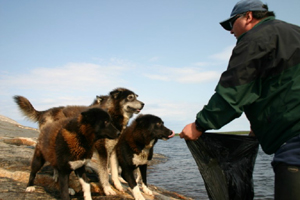
Allen Gordon with some of his
dogs
Photo:
Gordon
Allen Gordon
Kuujjuaq, Nunavik, CANADA
TFH: Could you
start by giving
us a short history of the ISD in Nunavik?
AG: According to the stories that I have heard from
the elders
in my community and the rest of Nunavik, the ISD was a big
part of the
nomadic Inuit people in terms of traveling, hunting,
fishing, gatherings,
trading and seasonal relocations of families. This
way of life all
started to change in the late 1950s and 1960s when the
Federal government
established permanent settlements around the coast of
Northern Quebec.
TFH When you were
growing up, did
your family use a dog team to hunt, fish and travel?
AG: When I was a child, I faintly remember my uncle
Norman Gordon's
sled dogs tied up behind their house. My two older
brothers, Mark
and Alec, used to follow Uncle Norman's dog team in
gathering trees for
firewood. According to my mother (who, by-the-way, raised
us three brothers
as a single parent), in the past dog teams were a big part
of her family.
The dogs were the only way to travel, especially to winter
trapping areas,
since fox pelts were the only source of income to buy
basic supplies from
the Hudson's Bay Company store in Fort Chimo. Also, she
mentions that Alex
Gordon, my late grandfather, used to deliver the mail by
dog sled for the
Hudson's Bay Company to Fort McKenzie. This old post was
about 100 miles
south of Kuujjuaq. From that post an Innu (Montagnais
Indian) would then
take the mail by foot to Seven Islands, a community on the
lower north
shore of the St. Lawrence River. The trading post in
Fort Chimo was
the main center of trade and gatherings for the Inuit of
lower Ungava Bay.
In 1941, during World War II, the American Army built an
air base four
miles upstream. All of the Inuit abandoned the post and
started to move
to the former military base, where services began
springing up in the late
1950s and 1960s. The growing community of Kuujjuaq
officially became a
municipality back in 1979.
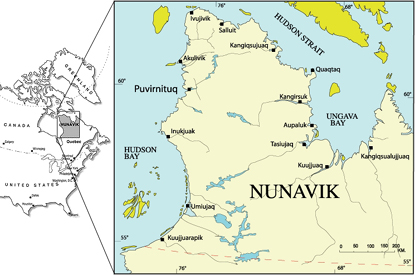
Maps:
Courtesy of Makivik Corporation
By the time I was six or seven years old most dog teams in my community were already gone and replaced by snowmobiles. However, I recall clearly when I was about five years old our neighbor, Joanasie Papak, still had Inuit Sled Dogs, and why I clearly remember him and his dog team occurred on Christmas Day. Joanasie's only passenger was Santa Claus. Joanasie's dogs suddenly took off running and Santa in full costume flipped and fell off the qamutik and he was in the snow with his feet high in the air!
TFH: Did you drive
dogs when you
were young?
AG: When I was young, I had only one dog, Brownie.
He was my
buddy for many years. I got Brownie from the village
to the east,
Kangisualujjuaq (George River), when he was just a tiny
puppy. He was just
few weeks old when I brought him home, the only survivor
from a litter
that was born under a house. The rest of puppies had all
frozen. When Brownie
grew, I put him in harness with my small qamutik that had
the traditional
frozen mud runners. For many years, almost every weekend,
I ran to my relatives'
old home village, which we today call Old Fort Chimo. To
me Brownie was
a true Inuk dog. He was very strong and a natural puller.
He would not
bark, mostly howl and had a habit of digging all the time.
He would bury
bones and food with his nose. He also loved to fight any
dog that was in
his reach. Brownie lived to be over ten years old.
He later came
down with an illness and had to be put down. I would
say Brownie
planted the dog sledding seed for me.
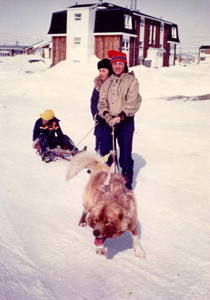
A young Allen with
Brownie Photo: Gordon
After graduating from Kuujjuaq high school, I decided that I wanted to start a dog team. There were a few guys in town starting to run dog teams again. That is when the blue-eyed dogs started to appear in Nunavik. Since there were no more native Inuit Dogs in town, a number of Siberian Huskies and Malamutes were brought in from the south and I started my new team from those bloodlines. The most number of dogs I had was ten and I enjoyed recreational mushing with them for a few years, although I did not undertake a major long distance trip with them. My job as a full time wildlife technician meant being away in the field for weeks at a time during the summer months. It became very difficult to take good care of my dogs, as I would rely on others for their feeding and care. When I returned to town my dogs would be in bad shape and I felt this was not fair to them, so I reluctantly gave them up in 1987.
TFH: As an adult,
why have you
decided to own and drive dogs?
AG: When I gave up my first team, I promised myself
that one
day I would own a dog team again. Over the years I
told a few friends
that a dog team would be more of a retirement hobby
project. Well,
I was wrong. I'm not near retirement, but the urge to run
dogs again just
struck me while ptarmigan hunting on a beautiful afternoon
in March 2003.
On a snowmobile, heading home, I was imagining going out
with dogs with
my kids and enjoying the fresh air without the sound of an
snowmobile engine.
I remembered the days when I would listen to the dogs
ivakkak (trot) and
the qamutik runners swishing across the frozen land and
lakes. When
I got home, I mentioned to my wife, Susie, what had got
into my mind earlier.
I expected her to just laugh at me, but to my surprise she
was very supportive
of the idea of getting dogs to build a team. You
see, she had seen
the last few dog teams in her home village of Tasiujaq.
Susie recalls as
a young girl trying to hop on qamutiit for short
rides when the dog
teams were leaving the village on fishing trips. Also, her
late father,
Johnny Cain, always had a dog team until the late 1970s.
So there are good
memories about dog sledding from her younger days.
I also want my two children to experience dog mushing and the care of dogs while they are young and imprint them with dog sledding. The kids of today are so much into television, computers and video games and spending so little time outdoors. I figure when my children are grown up they will remember our mushing trips and hopefully they will continue the tradition of running dog teams with their kids.
TFH: It would have
been easy for
you to assemble a team of "husky dogs". Please tell
us why you chose to
build a team of pure ISDs.
AG: Most of my current roster of dogs are mixed
huskies. They
probably have the genes of most northern type
huskies. Last July
I received two pups from Siu-Ling Han in Iqaluit, Nunavut,
and I can say
that these two females are pure ISD. Also in December, I
acquired a two-year-old
pure ISD male from Ludovic Pirani in southern Quebec. I'm
planning to breed
the females with this male and finally build up a team of
pure ISDs.
The reason I want to be the owner of pure Inuit Sled Dogs
is because they
are a big part of my Inuit cultural heritage and they were
once native
to this part of the Arctic up until the late 1970s.
Also, most of
the younger generation of Inuit don't know the differences
between pure
and mixed. I hope to educate them and promote the
return of the pure
ISD to Nunavik.
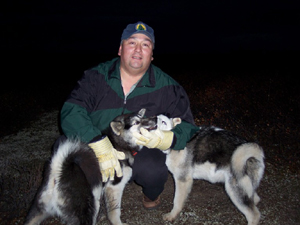
Allen and his two pure ISD bitch
pups
Photo: Gordon
TFH: How difficult
has it been
for you to get pure ISDs?
AG: It has been very difficult since I can't just
order pups
from someone in Nunavik, since no one here has pure ISDs
to sell (a couple
of other mushers here in Kuujjuaq got some of Siu-Ling's
pups the same
time I did). Some years ago when I was visiting
Iqaluit, I met Matty
McNair and saw her pure dogs. So last spring, I made
contact with Matty
and she lead me to her musher friend Siu-Ling Han.
Siu-Ling had a pregnant
female. Weeks later, I was very fortunate that Siu-Ling
gave me two beautiful
pups, although she did not know much about me or my dogs.
Even from Iqaluit,
male puppies are very hard to get since they are reserved
well in advance
before birth.
TFH: We know you
would like to
see interest in the pure ISD grow in Nunavik. What
do you feel is needed
to see this happen? Is there a role the ISDI can
play?
AG: First, it is all about education. Like I said,
most of the
younger generation needs to see, touch the dogs and really
understand the
physical characteristics of a true uncontaminated purebred
ISD. Also, regional
organizations, schools and municipalities in Nunavik could
all participate
and assist the mushers in getting proper secure kennels,
vet care, and
funds to buy breeding stock. From a successful breeding
program in some
communities the puppies could then be sent to all Nunavik
communities for
future generations to use in a traditional way, especially
the cultural
programs in the schools. I'm sure the ISDI could play a
role. Your organization
has many contacts and much expertise with regards to
breeders and enthusiasts
throughout the world.
TFH: In many
regions, dog teams
serve a function, primarily involving tourism. Is it
reasonable for Inuit
in your community to use dog teams for more than
just tourist related activities?
AG: As far as my community is concerned the ten or
so mushers
in town are not raising teams merely for tourism. We
all have different
personal reasons and there is no money in it. In fact it
is extremely expensive
for us to own a dog team. Actually dog team tourism
is not new to
Nunavik. I remember Italians and people from France
traveling by dog sled
down the coast with Inuit mushers every year and arriving
right at the
doorstep of the Arctic Travelers Hotel in Kuujjuaq during
the 1970s.
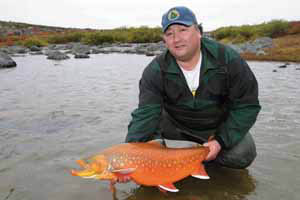
Allen displaying a beautiful Arctic
Char
Photo: Gordon
TFH: Tell us about
what you do
in Kuujjuaq. We understand you "wear many hats" and
are involved in several
ventures.
AG: My main job is with the Nunavik Tourism
Association as Executive
Director. I also own three outfitting camps offering
packages in
fishing and autumn caribou hunting. I'm the third
term elected President
of the Nayumivik Landholding Corporation which has title
to Inuit lands
surrounding Kuujjuaq and engaged in social and economic
development and
wildlife issues that benefit the Inuit of my
community. I also started
the very successful first Arctic Char Fish Hatchery in
Nunavik. I'm
with the Kuujjuaq Canadian Rangers Patrol. I'm on
the Board of Directors
of Kuujjuamiut, Inc., and Umiak Builders. In the
past I was elected
to the municipal council for three terms and was the
deputy Mayor of Kuujjuaq
once. I have not sought re-election with the council due
to all of the
other mandates.
TFH: Are you
planning any long
distance trips with your dogs?
AG: Yes, I've been planning to take a March break
and travel
with the dogs to my wife's home town of Tasiujaq
(population 250). The
community lies on the shores of Leaf Bay, just northwest
of Kuujjuaq and
about 100 miles by dog sled. Most of my dogs are
only two years old
so to me the trip, when completed, will be a major
achievement for them
and me getting back to mushing.